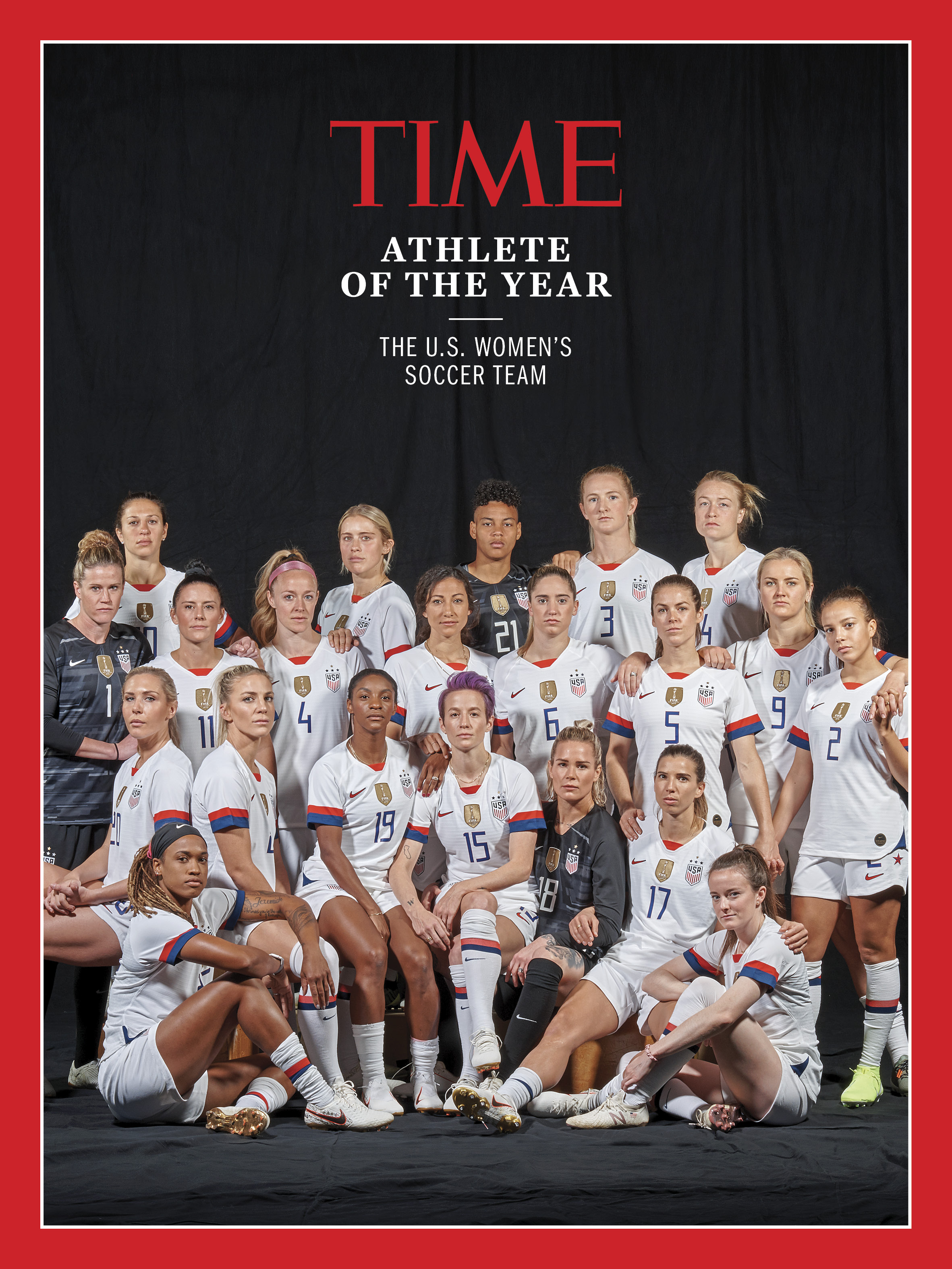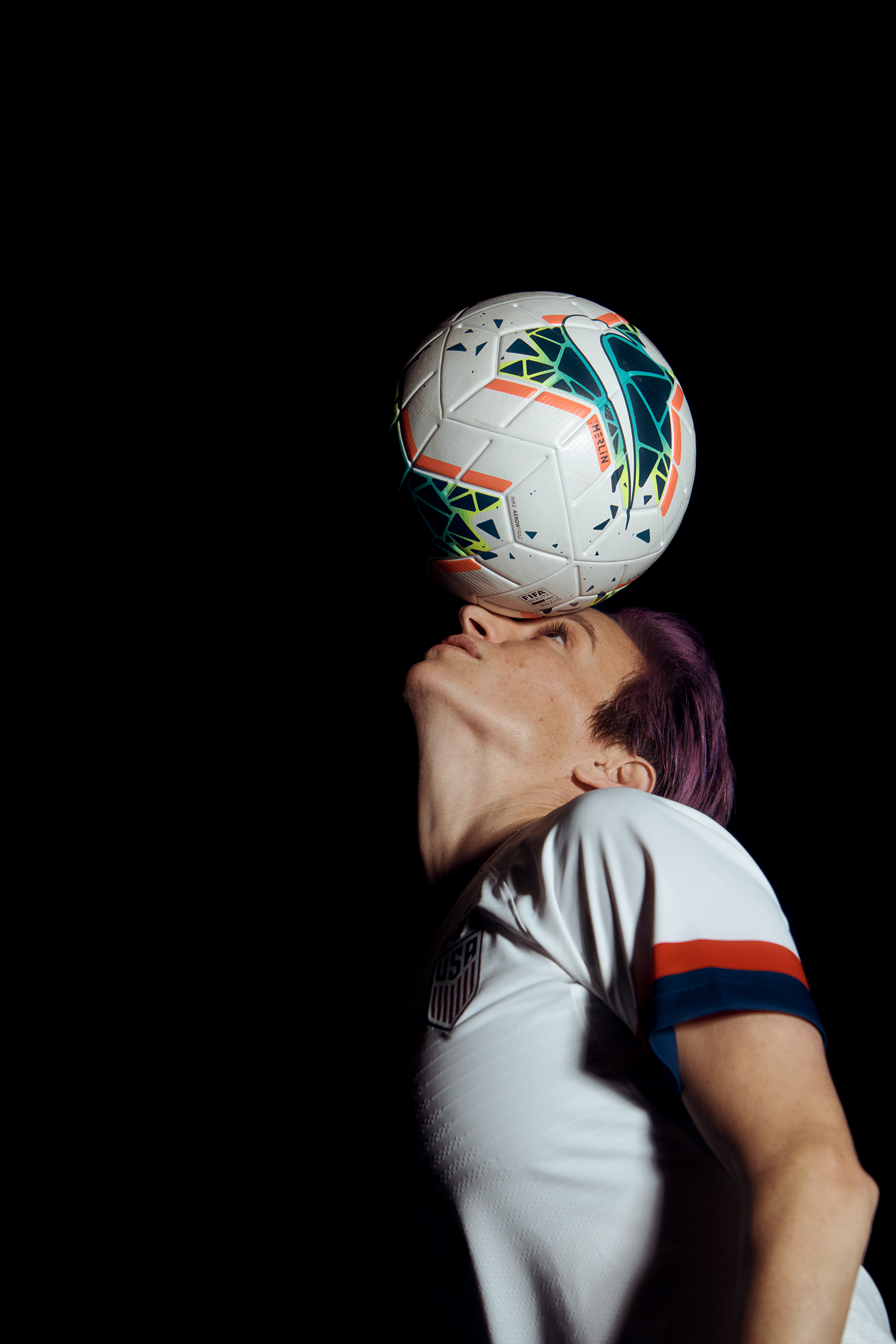It has been more than five months since the U.S. women’s soccer team won the World Cup, and yet barely a day goes by that Megan Rapinoe doesn’t hear about it from strangers. A young girl at a soccer clinic. A middle-aged man at an airport. Parents the world over via social media. No matter who or where, the topic is always the same: how the team changed a life.
A trophy—even for the world’s most prestigious soccer tournament—rarely alters the life of someone who didn’t win it. Nor does a game played in summer tend to generate dinner-table discussions as fall gives way to winter, least of all about gender equity in the workplace. But if there was any question before the World Cup that the U.S. had sent over a team that transcended sports, it was emphatically clear upon their return from France, at the ticker-tape parade through New York City’s Canyon of Heroes that welcomed them home. Thousands of supporters lined the streets of lower Manhattan to share the rapturous joy of 23 women whose unalloyed pride in their accomplishment, and determination to see it shared, seemed to mark a new era.
“It was like, Wow,” says Rapinoe, recalling not only the heady days after the victory but also the conversations with grateful strangers for months afterward. “We’re in a movement, not a moment.”
Sports tends to be thought of as an escape from the tumult of life beyond the field. And there are few things more enthralling than a brilliant goal, a sudden-death shoot-out, a last-second Hail Mary. But if you look closely, our diverting games are often an engine of change in the messy world outside the arena.
That much has long been apparent to the members of the U.S. women’s national team, who have historically made less and been treated worse than their male counterparts. The stories of the inequities are passed down from generation to generation on the team: the cramped travel and bug-infested hotel rooms in the ’80s and ’90s; the shoddy field conditions in the 2000s; and a bonus system that left the women with inferior earning opportunities, despite their superior results.

Photograph by Cait Oppermann for TIME
So after various efforts to resolve the pay dispute failed, the team sued their bosses for gender discrimination on March 8 of this year—International Women’s Day. Before they even set foot in France, the favored U.S. women were already playing for more than a trophy.
“They could have been all about themselves,” says Jennifer Klein, chief strategy and policy officer of the anti–sexual harassment organization Time’s Up, which has partnered with the team’s players association to promote equal pay. “Instead, they decided to shine a light on the pay gap not just for women in soccer, but for women worldwide.”
Despite the pressure, the U.S. women blitzed through the stacked field with infectious bravado. Rather than an added burden, their fight for equitable pay became a rallying cry, and they turned a soccer tournament into a master class in using an athletic platform to push for social progress. Chants of “Equal pay!” filled the Parc Olympique Lyonnais after nearly 60,000 people in the stadium and more than 260 million viewers worldwide, a record audience, watched America’s 2-0 victory over the Netherlands in the final.
Through it all, the team kept showing the world how to have a good time. And they allowed everyone else to share in their fun. Two days after President Donald Trump took aim at Rapinoe on Twitter for saying she would skip a White House visit if they won, she scored a pair of goals against France and marked them with a pose—arms outstretched, chin lifted in defiance—that served as its own rebuttal. When Alex Morgan headed in the go-ahead goal against England in the semifinals, she sported a grin that could have stretched across the Atlantic, and pantomimed sipping tea. And when the U.S. won it all despite it all, the players set off on a booze-drenched victory tour that would have made a college spring-breaker blush. The message was unmissable: If you fight for something important, something bigger than yourself, and earn every scrap of it, why shouldn’t you enjoy the ride?
“People always wonder, How the hell do these women act the way they do?” Rapinoe says, still relishing the triumph months later. “That’s the world we live in. There’s so much joy in realizing that the President of the United States can come at us, and we’re like, pfffffff, we don’t even need to respond back. There’s joy in realizing your power.”
***
Going into the World Cup, many of those most connected to America’s soccer apparatus—top federation officials, corporate sponsors, TV commentators—bandied about a rosy theory. This year’s event would be especially popular in the U.S. because, the thinking went, Americans would be thirsting for a distraction in these divided political times. Both sides of the aisle would rally around the top-ranked U.S. team, providing the country with a necessary dose of feel-good national unity.
Any “Kumbaya” vibe, however, was torpedoed after halftime of the first match. The U.S. opened its tournament with a 13-0 destruction of overmatched Thailand. The players displayed the same kind of exuberance for goals 9 and above as they did for 1, 2 and 3. Depending on your view, this was either a sign of poor sportsmanship or a proper reaction to the fulfillment of a lifelong dream: scoring at a World Cup.
“It’s someone’s prerogative to be saying, ‘They shouldn’t be doing this,’” says U.S. forward Christen Press. “And what makes our team what it is is nobody cares.”
What began as griping about the team’s arrogance on sports talk radio and social media soon escalated into a full-blown political proxy fight after the clip of Rapinoe swearing off a White House visit, which had been shot earlier in the year, was released ahead of the quarter-finals. “I’m not going to the f-cking White House,” she said. The following day Trump fired back, saying Rapinoe had disrespected the country, the White House and the flag.
The collision may have been inevitable. An out gay woman and vocal advocate for social justice, Rapinoe has never been shy about her feelings toward Trump—or much else. Before a 2016 game, she took a knee during the national anthem in solidarity with Colin Kaepernick. In France at the World Cup, she declined to put a hand to her heart, and stood stoic during the song. “There’s no greater example of white supremacy being alive and well,” Rapinoe says now, “than me standing here and getting to enjoy all this while Colin is still not playing.”
In France, Rapinoe essentially laughed off the spat with the leader of the free world—signaling to her teammates the need to focus on the task at hand. “I was taking my cues from Pinoe,” says teammate Becky Sauerbrunn. “She was yukking it up like her normal self. It put the team at ease.”

Rose Lavelle celebrates with teammates after scoring her team's second goal during the Women's World Cup Final in Lyon, France on July 07Catherine Ivill—FIFA/Getty Images
The larger sense of purpose ended up bringing this team together. The squad included a mix of veteran leaders like co-captains Morgan, Rapinoe and Carli Lloyd, and emerging stars such as Sam Mewis, Rose Lavelle and Lindsey Horan. The age blend could make for tricky chemistry. Under coach Jill Ellis, however, the team jelled. The old hands were a model of poise. Lloyd, the star of the 2015 World Cup win, was less than thrilled with her reduced on-field role, but she stayed supportive. And the veterans stepped up as spokes-people for the equal-pay fight and other off-field issues. “That was a really strong sign of leadership,” says Mewis. “It allowed players like me and Rose to just focus on playing, which was nerve-racking enough.”
The bond was reinforced after each game in the tournament, when the players spent about 30 minutes together before boarding the bus. No coaches or staff were allowed. “That really helped everyone see each other eye to eye,” says Morgan. “People would call out players positively, or themselves negatively. We could be vulnerable.”
What they could be was themselves. And it was precisely that honest, unfiltered and unapologetic quality that struck such a chord. The soccer insiders were right about Team USA becoming a national obsession. But they were wrong about the reason. The U.S. women didn’t evoke the easy feelings of patriotism that come from waving a flag so much as embody the evolving spirit of the more perfect union that it symbolizes.
The response was overwhelming. The team’s jerseys became the highest-selling soccer shirts in Nike’s history. On the online retailer Fanatics, U.S. jersey sales spiked 500% over the 2015 World Cup. Global viewership of the tournament more than doubled per match, and a combined 1.12 billion viewers worldwide tuned in to coverage of the event across all platforms, a new record. On Halloween, young boys as well as girls were spotted around the country dressed up as Rapinoe and Morgan.
Most important, the team’s fight for their fair share has been taken up far and wide. This fall, Australia’s soccer federation reached a landmark deal with its players: total revenue generated by both the women’s and men’s teams will now be split equally. In Burlington, Vt., a girls’ high school soccer team partnered with a local nonprofit, Change the Story, to sell athletic shirts emblazoned with #EQUALPAY.
“It’s scary that these women can be the best in the world and they’re still fighting for pay equality,” says Maia Vota, a senior on the Burlington High School team. “I don’t want to see that in my future.”

The U.S. team soaks in adulation at a ticker-tape parade in New York City on July 10John Lamparski—WireImage/Getty Images
The team’s campaign went viral when four players received excessive-celebration yellow cards for peeling off their uniform jerseys after scoring a goal, revealing the #EQUALPAY shirts. The money raised—more than $100,000—will help broaden access to soccer for girls in under-served communities and fund women’s economic-empowerment efforts in the state.
Among those who bought a shirt was Roger Ranz, the referee who issued the penalties. He says protocol required him to hand out the cards, but he fully supports the cause. “I believe in what they’re doing,” says Ranz. “I believe in what the U.S. women’s national soccer team is trying to accomplish as well.”
***
After their epic victory lap, the players returned in August to a less festive locale: conference rooms in New York City, for mediation talks with the governing body of American soccer. The negotiations broke down, and a trial date in the players’ gender-discrimination suit is set for May of next year.
The protracted dispute has started to wear on the team. “Everyone should be making more money,” says Rapinoe. “If we didn’t have to fight the federation all the time, we could actually put our collective power together with the federation. Imagine that?”
But in November, a federal judge offered the players encouragement by ruling that they can sue collectively in a class action. U.S. Soccer has maintained that its compensation practices are not discriminatory, noting that the women’s team, for example, was paid more in aggregate than the men’s in recent years. The judge said that line of reasoning would yield an “absurd result,” as it would mean “an employer who pays a woman $10 per hour and a man $20 per hour would not violate the Equal Pay Act … as long as the woman negated the obvious disparity by working twice as many hours.”
 |
| Rapinoe, the 2019 FIFA player of the year, scored six World Cup goals and won the Golden Ball as the event’s best player |
“This was a really important win for the players,” says Dionne Koller, director of the Center for Sport and the Law at the University of Baltimore School of Law. “The public sees that this claim is real.”
With the 2020 Olympics in July, the team must also keep its focus on the field. It’s possible the U.S. will bring a team to Tokyo that’s almost identical to the one that won the World Cup. Morgan, who is expecting her first child in April, plans to be there. No country has won the World Cup and Olympic gold in back-to-back years. But few are better positioned. On Dec. 2, Rapinoe won the Ballon d’Or, given to the best women’s player in the world. Morgan was third. The U.S. desperately wants to avoid a repeat of the 2016 Olympics, when Sweden eliminated the Americans in the quarter-finals, their earliest exit from a major international tournament.
But no matter how the team fares, its impact on American culture is secure. Through their athletic excellence and legal persistence, the team represents a natural extension of what Title IX—the landmark legislation ensuring equal access to sports—began in 1972. “It’s not enough to say, ‘Let women play soccer,’” says Koller. “Now, it’s ‘Treat women the same.’”
The team, which made that case so dazzlingly on the field in France, welcomes the weight of legacy. “This next generation wants to be a part of something big,” says Morgan. “They’re not just sayers. They’re doers. It’s our job to continue to pave the way.”
The work won’t stop anytime soon. “We’re here, we’re coming with armies and ladders on all sides of our platform,” says Rapinoe. “We want to bring people up. We’re not going anywhere. And we will change the world.”






0 Yorumlar